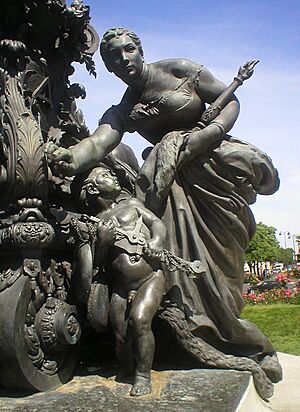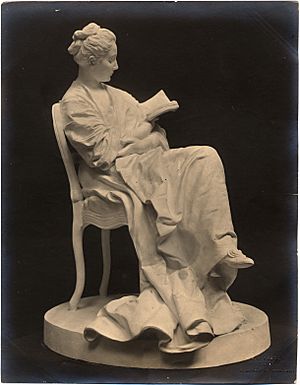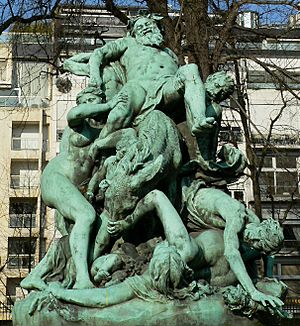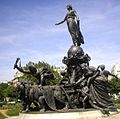Jules Dalou facts for kids
Quick facts for kids
Jules Dalou
|
|
|---|---|
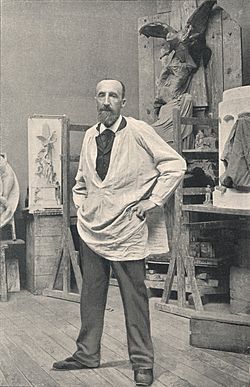
Jules Dalou in his studio, 1899
|
|
| Born |
Aimé-Jules Dalou
31 December 1838 Paris, France
|
| Died | 15 April 1902 (aged 63) Paris, France
|
| Nationality | French |
| Education | École nationale supérieure des Beaux-Arts |
| Known for | Sculpture |
|
Notable work
|
The Triumph of the Republic, 1899 The Triumph of Silenus, 1885 |
| Movement | New Sculpture |
| Awards | Commander of the Légion d'Honneur |
Aimé-Jules Dalou (December 31, 1838 – April 15, 1902) was a famous French sculptor from the 1800s. People admired his sculptures because they looked very real and showed deep feelings.
Contents
Early Life and Training
Jules Dalou was born in Paris, France. His family worked hard and believed in freedom and fairness for everyone.
When he was young, he studied art with Jean-Baptiste Carpeaux. Carpeaux helped him get into the Petite École, which later became a famous art school. There, Dalou became friends with other artists like Alphonse Legros and Fantin-Latour.
In 1854, he went to the École des Beaux-Arts de Paris. He learned to combine the lively style of his teacher, Carpeaux, with the classic rules of art. He also studied the works of famous sculptors like Giambologna and Pierre Puget.
Starting His Career
Dalou first showed his art at the Paris Salon in 1861. The Salon was a big art show where artists could display their work.
However, Dalou openly supported working-class people. This made it hard for him to get official art jobs during the French Second Empire. He was often denied the Prix de Rome, a prize that helped sculptors start their careers.
So, Dalou began working for decorators. This is how he met and became friends with the famous sculptor Auguste Rodin. He also made wax models for jewelry.
Dalou married Irma Vuillier, and they had a daughter named Georgette. His sculpture called Daphnis and Chloe was bought by the French government in 1869.
Time in England
In 1871, Dalou had to leave France. He had been involved with the Paris Commune, a group that took control of Paris for a short time. He became a curator at the Musée du Louvre under Gustave Courbet.
He moved to England in July 1871 and stayed with his friend, Alphonse Legros. In France, he was found guilty while he was away and given a life sentence.
In England, Dalou quickly became well-known. He taught at the South London Technical Art School and the South Kensington School of Art. He also suggested that his friend Édouard Lantéri move to England.
During his eight years in England, Dalou created many small terracotta sculptures. These included A French Peasant Woman and The Reader. He also made informal portrait busts of his friends.
He received important commissions, too. He created a large public fountain called Charity for the Royal Exchange, London in 1878. He also made a monument for Queen Victoria for her private chapel at Windsor Castle.
Return to France and Famous Works
In 1879, Dalou was able to return to France. This was after a general pardon was declared. He then created some of his most famous works.
One of his great sculptures was a relief called Mirabeau replying to Dreux-Brézé. It showed an important historical moment from 1789. He also made the beautiful panel Fraternity.
In 1885, he created The Triumph of Silenus. His most impressive work for the city of Paris was The Triumph of the Republic. He worked on this huge monument for twenty years. It stands in the Place de la Nation and shows a symbolic figure of the Republic on a chariot. Lions pull the chariot, led by Liberty, and joined by Labour and Justice.
Soon after, his Monument to Alphand (1899) was unveiled. It was as successful as his Monument to Delacroix in the Luxembourg Garden.
His last works, finished after he passed away, include a statue of Lazare Hoche in Quiberon (1902) and the Monument to Gambetta in Bordeaux (1904).
Dalou won the Grand Prix at the Exposition Universelle (1889), a big world's fair. He was also made a commander of the Legion of Honor, a very high award in France. He helped start the Société Nationale des Beaux-Arts and was the first president of its sculpture section.
Death and Legacy
Jules Dalou passed away in Paris on April 15, 1902, at the age of 63. He was buried in the Cimetière du Montparnasse in Paris. His sculptures are still highly valued today.
Other Works
- Antoine-Laurent Lavoisier, National Gallery of Scotland 1866
- Funerary monument to Auguste Blanqui, Père-Lachaise, 1885
- Monument to Victor Noir, Père-Lachaise, 1891
- Monument to Léon Gambetta, Bordeaux, completed after his death by Camille Lefèvre and installed in 1904
- Bust of Alfred Roll, ca 1895, terracotta model for the monument to Jean-Charles Adolphe Alphand, Paris, Musée du Petit Palais
- Fame, 1886, bronze, Bayonne, Musée Bonnat
- National Museum of Serbia
- Seating Male Figure, bronze, c.1885
- Musée d'Orsay, Paris
- Femme nue lisant dans un fauteuil, bronze, 1878
- Grand Paysan, bronze, 197 x 70 x 68 cm
- Liseuse, vers 1875, bronze
- Couseuse
- Travailleur debout tenant une bêche, bronze
- Tonnelier avec des cordes, bronze, for a projected Monument to Labour
- Rebatteur de faux, bronze, for the Monument to Labour
Images for kids
See also
 In Spanish: Jules Dalou para niños
In Spanish: Jules Dalou para niños


